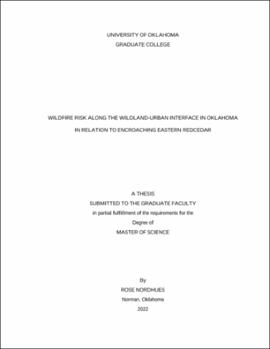Wildfire risk along the wildland-urban interface in Oklahoma in relation to encroaching eastern redcedar
| dc.contributor.advisor | Shafer, Mark | |
| dc.contributor.author | Nordhues, Rose | |
| dc.date.accessioned | 2022-12-15T19:38:08Z | |
| dc.date.available | 2022-12-15T19:38:08Z | |
| dc.date.issued | 2022-12-16 | |
| dc.identifier.uri | https://hdl.handle.net/11244/336944 | |
| dc.description.abstract | Across the United States, the number of wildfires has been increasing, but this can especially be felt in the Great Plains, where some of the most drastic increases in wildfire frequency and size have occurred. While frequent fires should seem somewhat normal in a grassland biome like Oklahoma, after European settlement, fire suppression has allowed woody vegetation, like Eastern Redcedar, to encroach onto the grasslands and dominate native vegetation. This leads to state transitions of a grassland biome to a woodier ecosystem, which can cause more intense wildfires. The metropolitan areas outside of Oklahoma City and Tulsa have the highest housing and population densities at risk and largest magnitude of wildland-urban interface. But some rural areas like Hinton and Woodward to Watonga show a high risk to wildfire in proportion to their low populations. Landowners need to properly manage these areas to prevent fires rather than suppressing them. | en_US |
| dc.language | en_US | en_US |
| dc.subject | wildfire | en_US |
| dc.subject | wildland-urban interface | en_US |
| dc.subject | eastern redcedar | en_US |
| dc.subject | encroachment | en_US |
| dc.subject | risk | en_US |
| dc.title | Wildfire risk along the wildland-urban interface in Oklahoma in relation to encroaching eastern redcedar | en_US |
| dc.contributor.committeeMember | Hoagland, Bruce | |
| dc.contributor.committeeMember | Loraamm, Rebecca | |
| dc.date.manuscript | 2022 | |
| dc.thesis.degree | Master of Science | en_US |
| ou.group | College of Atmospheric and Geographic Sciences::Department of Geography and Environmental Sustainability | en_US |
| shareok.nativefileaccess | restricted | en_US |
Files in this item
This item appears in the following Collection(s)
-
OU - Theses [2155]
